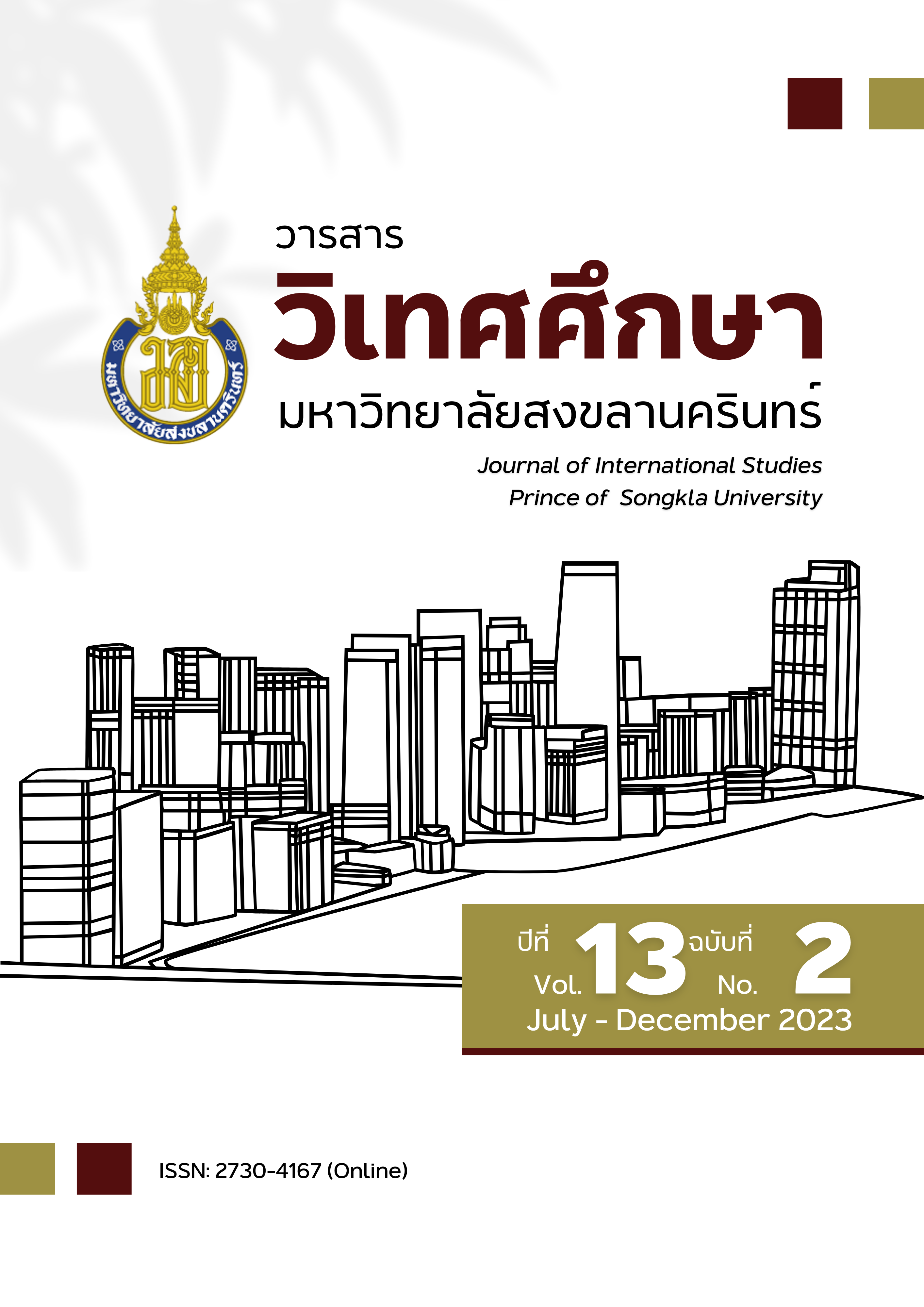ปัจจัยในการเลือกร้านอาหาร การรับรู้ความเสี่ยงจากการติดเชื้อ COVID-19 และการป้องกันตนเองของลูกค้าในร้านอาหาร
Main Article Content
บทคัดย่อ
งานวิจัยนี้นำเสนอข้อมูลเชิงลึกเกี่ยวกับความสัมพันธ์ระหว่างการรับรู้ความเสี่ยงในการแพร่ระบาดของ COVID-19 ของลูกค้าร้านอาหารกับปัจจัยในการเลือกร้านอาหาร ความตั้งใจที่ในการป้องกันตนเองและการป้องกันตนเองท่ามกลางการแพร่ระบาดของไวรัสโควิด-19 โดยใช้ทฤษฎี Protection Motivation เป็นกรอบการวิจัย จากการศึกษาของชาวภูเก็ตจำนวน 456 คน ผลการวิจัยยืนยันอิทธิพลของปัจจัยสำคัญ 3 ประการในการเลือกร้านอาหารและการรับรู้ความเสี่ยง ได้แก่ ความสะอาดและสุขอนามัย ความรู้เกี่ยวกับโควิด-19 และการรับรู้ความรุนแรงของไวรัสโควิด-19 ที่มีต่อการป้องกันตนเอง และนำเสนอการอภิปรายผลการศึกษาในทางวิชาการและข้อเสนอแนะในการจัดการร้านอาหาร
Article Details

อนุญาตภายใต้เงื่อนไข Creative Commons Attribution-NonCommercial-NoDerivatives 4.0 International License.
ข้อความและความคิดเห็นที่แสดงในบทความ เป็นแนวคิดของผู้เขียน มิใช่ความรับผิดชอบของกองบรรณาธิการ และคณะผู้จัดทำแต่อย่างใด
บทความ ข้อมูล เนื้อหา รูปภาพ ฯลฯ ที่ได้รับการตีพิมพ์ในวารสารวิเทศศึกษา ถือเป็นลิขสิทธิ์ของวารสารวิเทศศึกษา หากบุคคลหรือหน่วยงานใดต้องการนำทั้งหมดหรือส่วนหนึ่งส่วนใดไปเผยแพร่ต่อหรือเพื่อกระทำการใด ๆ จะต้องได้รับอนุญาตเป็นลายลักษณ์อักษรจากวารสารวิเทศศึกษา ก่อนเท่านั้น
เอกสารอ้างอิง
Choi, J., Nelson, D., & Almanza, B. (2019). Food safety risk for restaurant management: use of restaurant health inspection report to predict consumers’ behavioral intention. Journal of Risk Research, 22(11), 1443–1457. https://doi.org/10.1080/13669877.2018.1501590
Jeong, M., Kim, K., Ma, F., & DiPietro, R. (2022). Key factors driving customers’ restaurant dining behavior during the COVID-19 pandemic. International Journal of Contemporary Hospitality Management, 34(2), 836-858. https://www.emerald.com/insight/content/doi/10.1108/IJCHM-07-2021-0831/full/html?skipTracking=true
Kim, K., Bonn, M.A., & Cho, M. (2021). Clean safety message framing as survival strategies for small independent restaurants during the COVID-19 pandemic. Journal of Hospitality Tourism Management, 46, 423–431. https://doi.org/10.1016/j.jhtm.2021.01.016
Kivela, J.J. (1997). Restaurant marketing: selection and segmentation in Hong Kong. International Journal of Contemporary Hospitality Management, 9(3), 116-123. https://www.emerald.com/insight/content/doi/10.1108/09596119710164650/full/html
Liu, P., & Tse, E. C. Y. (2018). Exploring factors on customers’ restaurant choice: an analysis of restaurant attributes. British Food Journal, 120(10), 2289-2303. https://www.emerald.com/insight/content/doi/10.1108/BFJ-10-2017-0561/full/html
Pallant, J. (2020). SPSS survival manual: A step by step guide to data analysis using IBM SPSS. McGraw-hill education (UK).
Rogers, R.W. (1975). A protection motivation theory of fear appeals and attitude change. Journal of Psychology, 91 (1), 93–114. doi:10.1080/00223980.1975.9915803.
Ruan, W., Kang, S., Song, & H. (2020). Applying protection motivation theory to understand international tourists’ behavioural intentions under the threat of air pollution: a case of Beijing, China. Current Issues in Tourism, 23(16), 2027–2041. ttps://doi.org/10.1080/13683500.2020.1743242
Ryu, K., Jarumaneerat, T., Promsivapallop, P., & Kim, M. (2023). What influences restaurant dining out and diners’ self-protective intention during the COVID-19 pandemic: Applying the Protection Motivation Theory. International Journal of Hospitality Management, 109, 103400. https://doi.org/10.1016/j.ijhm.2022.103400
Wang, J., Liu-Lastres, B., Ritchie, B.W., Mills, & D.J. (2019). Travellers’ self-protections against health risks: an application of the full Protection Motivation Theory. Annals of Tourism Research, 78, 102743. https://doi.org/10.1016/j.annals.2019.102743
Xiao, H., Peng, M., Yan, H., Gao, M., Li, J., Yu, B., Li, & S., et al. (2016). An instrument based on protection motivation theory to predict Chinese adolescents’ intention to engage in protective behaviors against schistosomiasis. Global Health Research Policy, 1(1), 1–9. doi:10.1186/s41256-016-0015-6
Yasami, M. (2021). International tourists’ threat appraisal, coping appraisal, and protection intention. Journal of Quality Assurance in Hospitality and Tourism, 22(2), 163–190. https://doi.org/10.1080/1528008X.2020.1768460
Yasami, M., Rabiul, M. K., Promsivapallop, P., & Zhu, H. (2022). The COVID-19 crisis and factors driving international tourists’ preferences for contactless dining services. International Journal of Contemporary Hospitality Management, 34(11), 4029-4051.
Yasami, M., Wongwattanakit, C., & Promphitak, K.T. (2020). International tourists’ protection intentions to use food hygiene cues in the choice of destination local restaurants. Geo Journal of Tourism and Geosites, 29(2), 583-596. DOI:10.30892/gtg.29216-491
Zapata-Cuervo, N., Montes-Guerra, M. I., & Jeong, M. (2023). How do restaurants respond to the COVID-19 pandemic? Lessons from Colombian restauranteurs and their survival strategies. Journal of Foodservice Business Research, 26(2), 186-207. https://doi.org/10.1080/15378020.2021.2006037


